信息系统改变工作方式
- 格式:docx
- 大小:25.63 KB
- 文档页数:6
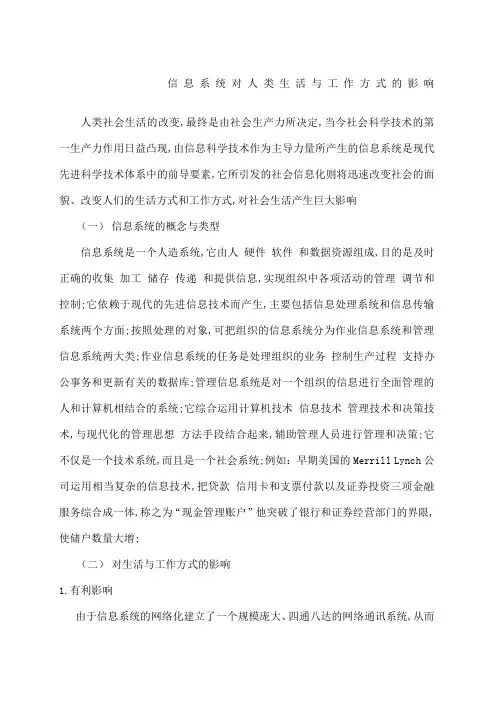
信息系统对人类生活与工作方式的影响人类社会生活的改变,最终是由社会生产力所决定,当今社会科学技术的第一生产力作用日益凸现,由信息科学技术作为主导力量所产生的信息系统是现代先进科学技术体系中的前导要素,它所引发的社会信息化则将迅速改变社会的面貌、改变人们的生活方式和工作方式,对社会生活产生巨大影响(一)信息系统的概念与类型信息系统是一个人造系统,它由人硬件软件和数据资源组成,目的是及时正确的收集加工储存传递和提供信息,实现组织中各项活动的管理调节和控制;它依赖于现代的先进信息技术而产生,主要包括信息处理系统和信息传输系统两个方面;按照处理的对象,可把组织的信息系统分为作业信息系统和管理信息系统两大类;作业信息系统的任务是处理组织的业务控制生产过程支持办公事务和更新有关的数据库;管理信息系统是对一个组织的信息进行全面管理的人和计算机相结合的系统;它综合运用计算机技术信息技术管理技术和决策技术,与现代化的管理思想方法手段结合起来,辅助管理人员进行管理和决策;它不仅是一个技术系统,而且是一个社会系统;例如:早期美国的Merrill Lynch公司运用相当复杂的信息技术,把贷款信用卡和支票付款以及证券投资三项金融服务综合成一体,称之为“现金管理账户”他突破了银行和证券经营部门的界限,使储户数量大增;(二)对生活与工作方式的影响1.有利影响由于信息系统的网络化建立了一个规模庞大、四通八达的网络通讯系统,从而信息作为最有效、最有价值的资源,改变了传统的生活方式;信息技术的广泛应用促进了人们的工作效率和生活质量的提高,人们的工作方式和学习方式也正发生转变.足不出户可知天下事,人不离家照样能办事.网上看病,网上授课,网上学习,网上会议,网上购物,网上洽谈生意,网上娱乐等成为人们一种新型的生活方式.网络技术,多媒体技术在教学上的应用,使得人们的学习内容更丰富,学习方式更灵活.真正做到了不出家门便可解决身边琐事 ;如到银行取款,我们不必排队等上几个小时,因为自动取款机为我们提供24小时的服务,速度快,效率高;或者直接登录网上银行,轻点几下鼠标汇款转账便可轻松处理;我们也不必为了买一双鞋而在商店逛上一上午,因为我们可以在网上选择自己满意的鞋子;信息系统还能实现办公自动化,无纸化,在办公自动化管理信息系统中,主要应用技术有:局域网,打印,传真,印刷,微缩等,能够提高办公事务效率,甚至可以实现在家上班;信息网络系统广泛地影响着人们的生活方式;通过国家或国际的通信系统,人与人之间的信息交流不再受时间与地域的限制,电子化书信的往来将人们更紧密地联系在一起;对文娱与新闻的获取将由被动接受变为主动选取,个性化风格得以增强;电子货币与自动购销系统大大方便了人们的消费,改变了人们的生活与消费习惯;信息系统的应用使团体工作不必面对面地坐在一起;人们可以在家里办公,并随时保持与同事之间的联系;这些都是信息系统的发展为我们带来的好处;2.信息技术可能带来的一些消极影响.信息系统渗透到人们的生活与工作中,一方面给社会带来了许多便利,但另一方面也可能给社会造成一些不利的影响;对信息技术可能带来的一些负面影响,我们必须要有足够清醒的认识,设法消除其不利影响;例如,在全球范围内,随着文化交流的扩大、交流内容的增加与交流方式的便捷,会使某些民族文化受到冲击;人们由直接交流变为间接交流,将在某种程度上淡薄感情色彩等等;如信息窃取,信息欺诈,信息攻击和破坏等,造成了社会危害. 1信息泛滥.一方面是信息急剧增长,另一方面是人们消耗了大量的时间却找不到有用的信息,信息的增长速度超出了人们的承受能力,导致信息泛滥的出现.2信息污染.一些错误信息,虚假信息,污秽信息等混杂在各种信息资源中,使人们对错难分,真假难辨;人们如果不加分析,便容易上当受骗,受其毒害.3信息犯罪.随着信息技术应用的普及,人们对信息体系的依赖性越来越强,信息安全已成为日趋突出的问题.一些不法分子利用信息技术手段及信息系统本身的安全漏洞,进行犯罪活动,如果系统出现问题和故障,将导致整个瘫痪,导致巨大的损害,特别是对大型的信息系统,危害更大;但是,利大于弊,因此现阶段各国普遍加强了对信息方面的立法,例如:加拿大的“信息查询法”,英国的“数据保护法”,美国最近刚刚通过的“信息自由法令”,经济合作与发展组织的“过境数据流的宣言”等,以及我国制定的“信息技术发展政策要点”和“计算机软件保护条例”等法规和政策;信息系统无处不在,小到我们学习啊的一卡通系统,大到为国家,企业决策的信息系统,随着它的发展和完善,信息系统将为我们的生活提供更多的方便服务;总之,信息系统的应用已迅速地改变人们生活与工作格局,对人们的习惯、习俗和心理产生深远的影响。
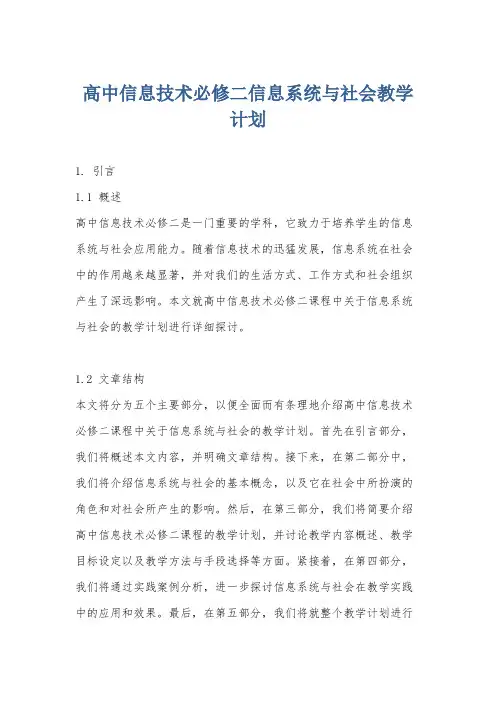
高中信息技术必修二信息系统与社会教学计划1. 引言1.1 概述高中信息技术必修二是一门重要的学科,它致力于培养学生的信息系统与社会应用能力。
随着信息技术的迅猛发展,信息系统在社会中的作用越来越显著,并对我们的生活方式、工作方式和社会组织产生了深远影响。
本文就高中信息技术必修二课程中关于信息系统与社会的教学计划进行详细探讨。
1.2 文章结构本文将分为五个主要部分,以便全面而有条理地介绍高中信息技术必修二课程中关于信息系统与社会的教学计划。
首先在引言部分,我们将概述本文内容,并明确文章结构。
接下来,在第二部分中,我们将介绍信息系统与社会的基本概念,以及它在社会中所扮演的角色和对社会所产生的影响。
然后,在第三部分,我们将简要介绍高中信息技术必修二课程的教学计划,并讨论教学内容概述、教学目标设定以及教学方法与手段选择等方面。
紧接着,在第四部分,我们将通过实践案例分析,进一步探讨信息系统与社会在教学实践中的应用和效果。
最后,在第五部分,我们将就整个教学计划进行总结,讨论其实际应用价值,并展望未来教学发展方向及可能挑战。
1.3 目的本文的主要目的是对高中信息技术必修二课程中关于信息系统与社会的教学计划进行深入研究和探讨。
通过对概念、作用和影响等方面的介绍,以及教学计划的设计与实施分析,旨在提升学生对信息系统与社会关系的理解能力,培养他们在日常生活和职业发展中灵活运用信息技术的能力。
同时,通过案例分析和效果评估等方法,也旨在为今后改进课程设计和教学方法提供参考,并为促进信息技术教育的发展贡献智慧和经验。
以上就是本文“1. 引言”部分内容。
引言旨在简要介绍文章主题及结构安排,并说明文章撰写目的。
接下来我们将逐一展开介绍各个部分内容,以便全面阐述高中信息技术必修二课程中关于信息系统与社会的教学计划。
2. 信息系统与社会概述2.1 信息系统基本概念信息系统是由一组相互关联的组件和过程组成,旨在收集、存储、处理和传递信息。
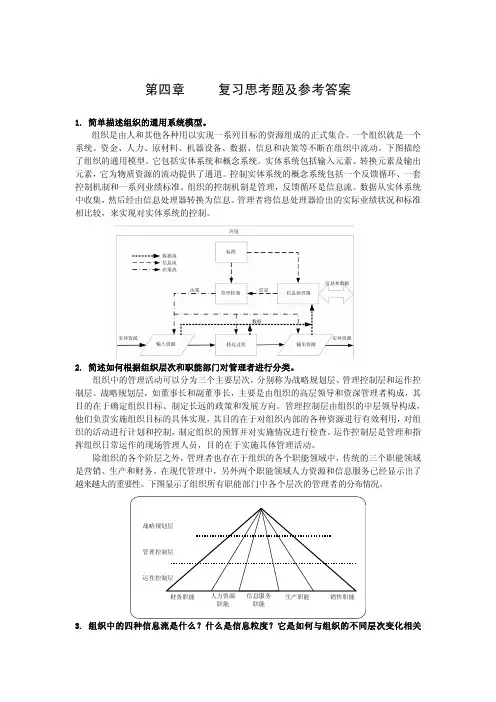
第四章复习思考题及参考答案1. 简单描述组织的通用系统模型。
组织是由人和其他各种用以实现一系列目标的资源组成的正式集合。
一个组织就是一个系统。
资金、人力、原材料、机器设备、数据、信息和决策等不断在组织中流动。
下图描绘了组织的通用模型。
它包括实体系统和概念系统。
实体系统包括输入元素、转换元素及输出元素,它为物质资源的流动提供了通道。
控制实体系统的概念系统包括一个反馈循环、一套控制机制和一系列业绩标准。
组织的控制机制是管理,反馈循环是信息流。
数据从实体系统中收集,然后经由信息处理器转换为信息。
管理者将信息处理器给出的实际业绩状况和标准相比较,来实现对实体系统的控制。
2. 简述如何根据组织层次和职能部门对管理者进行分类。
组织中的管理活动可以分为三个主要层次,分别称为战略规划层、管理控制层和运作控制层。
战略规划层,如董事长和副董事长,主要是由组织的高层领导和资深管理者构成,其目的在于确定组织目标、制定长远的政策和发展方向。
管理控制层由组织的中层领导构成,他们负责实施组织目标的具体实现,其目的在于对组织内部的各种资源进行有效利用,对组织的活动进行计划和控制,制定组织的预算并对实施情况进行检查。
运作控制层是管理和指挥组织日常运作的现场管理人员,目的在于实施具体管理活动。
除组织的各个阶层之外,管理者也存在于组织的各个职能领域中,传统的三个职能领域是营销、生产和财务。
在现代管理中,另外两个职能领域人力资源和信息服务已经显示出了越来越大的重要性。
下图显示了组织所有职能部门中各个层次的管理者的分布情况。
3. 组织中的四种信息流是什么?什么是信息粒度?它是如何与组织的不同层次变化相关联的?组织中的信息面向4个方向流动,即向上、向下、水平和向外。
信息向上流动(或说向上流动的信息)描述了基于日常事务处理的组织当前状态。
信息收集将信息向上传送给负责监督并对问题和机遇做出相应对策的决策者们。
向下流动的信息包括源于最高层的战略、目标和指令,这些信息是向较低的层次流动。

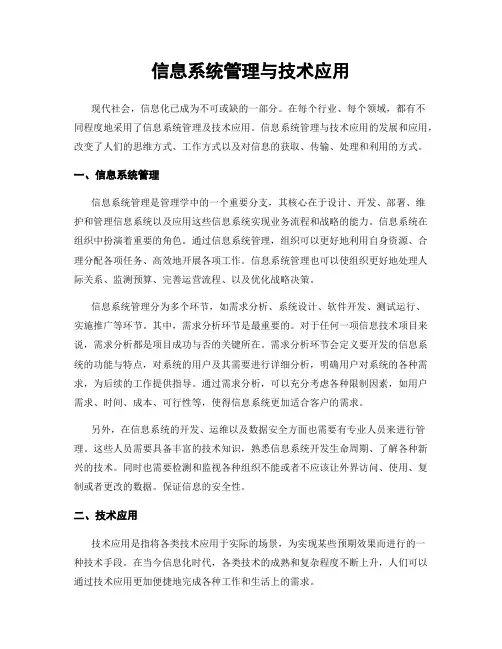
信息系统管理与技术应用现代社会,信息化已成为不可或缺的一部分。
在每个行业、每个领域,都有不同程度地采用了信息系统管理及技术应用。
信息系统管理与技术应用的发展和应用,改变了人们的思维方式、工作方式以及对信息的获取、传输、处理和利用的方式。
一、信息系统管理信息系统管理是管理学中的一个重要分支,其核心在于设计、开发、部署、维护和管理信息系统以及应用这些信息系统实现业务流程和战略的能力。
信息系统在组织中扮演着重要的角色。
通过信息系统管理,组织可以更好地利用自身资源、合理分配各项任务、高效地开展各项工作。
信息系统管理也可以使组织更好地处理人际关系、监测预算、完善运营流程、以及优化战略决策。
信息系统管理分为多个环节,如需求分析、系统设计、软件开发、测试运行、实施推广等环节。
其中,需求分析环节是最重要的。
对于任何一项信息技术项目来说,需求分析都是项目成功与否的关键所在。
需求分析环节会定义要开发的信息系统的功能与特点,对系统的用户及其需要进行详细分析,明确用户对系统的各种需求,为后续的工作提供指导。
通过需求分析,可以充分考虑各种限制因素,如用户需求、时间、成本、可行性等,使得信息系统更加适合客户的需求。
另外,在信息系统的开发、运维以及数据安全方面也需要有专业人员来进行管理。
这些人员需要具备丰富的技术知识,熟悉信息系统开发生命周期、了解各种新兴的技术。
同时也需要检测和监视各种组织不能或者不应该让外界访问、使用、复制或者更改的数据。
保证信息的安全性。
二、技术应用技术应用是指将各类技术应用于实际的场景,为实现某些预期效果而进行的一种技术手段。
在当今信息化时代,各类技术的成熟和复杂程度不断上升,人们可以通过技术应用更加便捷地完成各种工作和生活上的需求。
例如在物流领域,透过 RFID 标签等技术手段实现了对物品的跟踪、追踪和管理,优化了物料流的处理流程;在金融领域,人们可以通过手机、电脑等设备随时随地进行银行转账、理财管理、证券交易等业务,提供了更方便、快捷的金融服务。
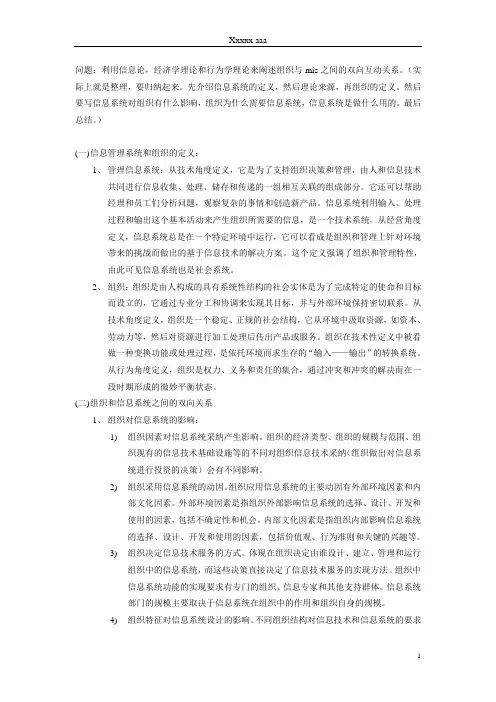
问题:利用信息论,经济学理论和行为学理论来阐述组织与mis之间的双向互动关系。
(实际上就是整理,要归纳起来。
先介绍信息系统的定义,然后理论来源,再组织的定义。
然后要写信息系统对组织有什么影响,组织为什么需要信息系统,信息系统是做什么用的。
最后总结。
)(一)信息管理系统和组织的定义:1、管理信息系统:从技术角度定义,它是为了支持组织决策和管理,由人和信息技术共同进行信息收集、处理、储存和传递的一组相互关联的组成部分。
它还可以帮助经理和员工们分析问题,观察复杂的事情和创造新产品。
信息系统利用输入、处理过程和输出这个基本活动来产生组织所需要的信息,是一个技术系统。
从经营角度定义,信息系统总是在一个特定环境中运行,它可以看成是组织和管理上针对环境带来的挑战而做出的基于信息技术的解决方案。
这个定义强调了组织和管理特性,由此可见信息系统也是社会系统。
2、组织:组织是由人构成的具有系统性结构的社会实体是为了完成特定的使命和目标而设立的,它通过专业分工和协调来实现其目标,并与外部环境保持密切联系。
从技术角度定义,组织是一个稳定、正规的社会结构,它从环境中汲取资源,如资本、劳动力等,然后对资源进行加工处理后传出产品或服务。
组织在技术性定义中被看做一种变换功能或处理过程,是依托环境而求生存的“输入——输出”的转换系统。
从行为角度定义,组织是权力、义务和责任的集合,通过冲突和冲突的解决而在一段时期形成的微妙平衡状态。
(二)组织和信息系统之间的双向关系1、组织对信息系统的影响:1)组织因素对信息系统采纳产生影响。
组织的经济类型、组织的规模与范围、组织现有的信息技术基础设施等的不同对组织信息技术采纳(组织做出对信息系统进行投资的决策)会有不同影响。
2)组织采用信息系统的动因。
组织应用信息系统的主要动因有外部环境因素和内部文化因素。
外部环境因素是指组织外部影响信息系统的选择、设计、开发和使用的因素,包括不确定性和机会。
内部文化因素是指组织内部影响信息系统的选择、设计、开发和使用的因素,包括价值观、行为准则和关键的兴趣等。
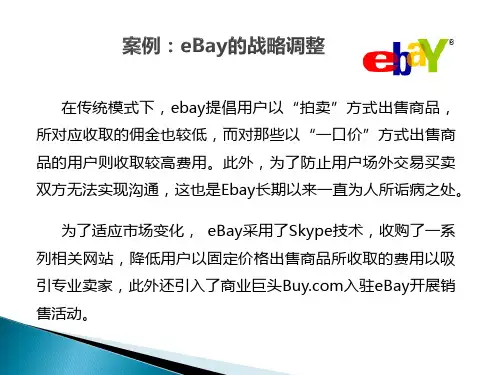
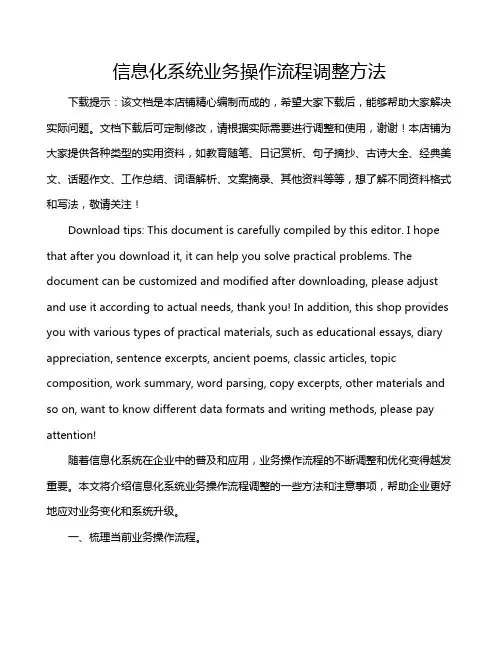
信息化系统业务操作流程调整方法下载提示:该文档是本店铺精心编制而成的,希望大家下载后,能够帮助大家解决实际问题。
文档下载后可定制修改,请根据实际需要进行调整和使用,谢谢!本店铺为大家提供各种类型的实用资料,如教育随笔、日记赏析、句子摘抄、古诗大全、经典美文、话题作文、工作总结、词语解析、文案摘录、其他资料等等,想了解不同资料格式和写法,敬请关注!Download tips: This document is carefully compiled by this editor. I hope that after you download it, it can help you solve practical problems. The document can be customized and modified after downloading, please adjust and use it according to actual needs, thank you! In addition, this shop provides you with various types of practical materials, such as educational essays, diary appreciation, sentence excerpts, ancient poems, classic articles, topic composition, work summary, word parsing, copy excerpts, other materials and so on, want to know different data formats and writing methods, please pay attention!随着信息化系统在企业中的普及和应用,业务操作流程的不断调整和优化变得越发重要。
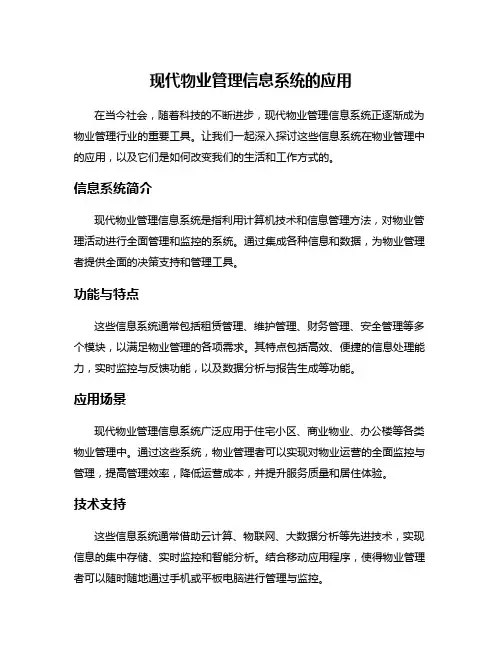
现代物业管理信息系统的应用
在当今社会,随着科技的不断进步,现代物业管理信息系统正逐渐成为物业管理行业的重要工具。
让我们一起深入探讨这些信息系统在物业管理中的应用,以及它们是如何改变我们的生活和工作方式的。
信息系统简介
现代物业管理信息系统是指利用计算机技术和信息管理方法,对物业管理活动进行全面管理和监控的系统。
通过集成各种信息和数据,为物业管理者提供全面的决策支持和管理工具。
功能与特点
这些信息系统通常包括租赁管理、维护管理、财务管理、安全管理等多个模块,以满足物业管理的各项需求。
其特点包括高效、便捷的信息处理能力,实时监控与反馈功能,以及数据分析与报告生成等功能。
应用场景
现代物业管理信息系统广泛应用于住宅小区、商业物业、办公楼等各类物业管理中。
通过这些系统,物业管理者可以实现对物业运营的全面监控与管理,提高管理效率,降低运营成本,并提升服务质量和居住体验。
技术支持
这些信息系统通常借助云计算、物联网、大数据分析等先进技术,实现信息的集中存储、实时监控和智能分析。
结合移动应用程序,使得物业管理者可以随时随地通过手机或平板电脑进行管理与监控。
现代物业管理信息系统的应用,极大地提升了物业管理的效率与质量,为业主和租户提供了更便捷、安全、舒适的居住和工作环境。
这些系统的不断发展与完善,将进一步推动物业管理行业向智能化、数字化发展,为城市的可持续发展和社会的进步提供强大支持。
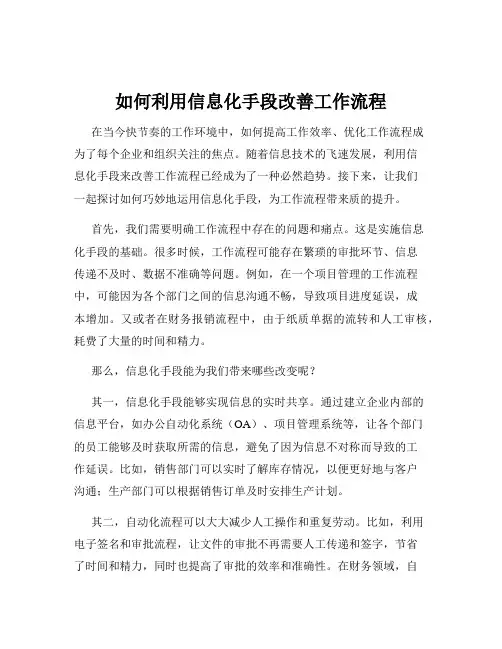
如何利用信息化手段改善工作流程在当今快节奏的工作环境中,如何提高工作效率、优化工作流程成为了每个企业和组织关注的焦点。
随着信息技术的飞速发展,利用信息化手段来改善工作流程已经成为了一种必然趋势。
接下来,让我们一起探讨如何巧妙地运用信息化手段,为工作流程带来质的提升。
首先,我们需要明确工作流程中存在的问题和痛点。
这是实施信息化手段的基础。
很多时候,工作流程可能存在繁琐的审批环节、信息传递不及时、数据不准确等问题。
例如,在一个项目管理的工作流程中,可能因为各个部门之间的信息沟通不畅,导致项目进度延误,成本增加。
又或者在财务报销流程中,由于纸质单据的流转和人工审核,耗费了大量的时间和精力。
那么,信息化手段能为我们带来哪些改变呢?其一,信息化手段能够实现信息的实时共享。
通过建立企业内部的信息平台,如办公自动化系统(OA)、项目管理系统等,让各个部门的员工能够及时获取所需的信息,避免了因为信息不对称而导致的工作延误。
比如,销售部门可以实时了解库存情况,以便更好地与客户沟通;生产部门可以根据销售订单及时安排生产计划。
其二,自动化流程可以大大减少人工操作和重复劳动。
比如,利用电子签名和审批流程,让文件的审批不再需要人工传递和签字,节省了时间和精力,同时也提高了审批的效率和准确性。
在财务领域,自动化的报销系统可以根据预设的规则自动审核报销单据,减少了人工审核的工作量。
其三,信息化手段有助于数据的收集和分析。
通过各种信息系统,我们可以收集到大量的工作数据,然后运用数据分析工具,对这些数据进行深入挖掘和分析,从而发现工作流程中的潜在问题和优化空间。
例如,通过对客户投诉数据的分析,找出产品或服务的不足之处,进而改进工作流程,提高客户满意度。
要成功利用信息化手段改善工作流程,以下几个步骤是关键:第一步,进行全面的需求分析。
了解各个部门的工作流程和需求,明确哪些环节需要优化,以及希望通过信息化手段达到什么样的效果。
这需要与不同部门的员工进行充分的沟通和交流,获取他们的意见和建议。
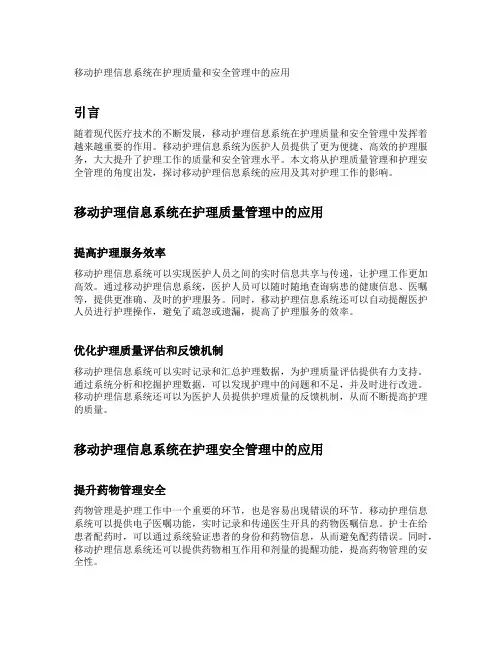
移动护理信息系统在护理质量和安全管理中的应用引言随着现代医疗技术的不断发展,移动护理信息系统在护理质量和安全管理中发挥着越来越重要的作用。
移动护理信息系统为医护人员提供了更为便捷、高效的护理服务,大大提升了护理工作的质量和安全管理水平。
本文将从护理质量管理和护理安全管理的角度出发,探讨移动护理信息系统的应用及其对护理工作的影响。
移动护理信息系统在护理质量管理中的应用提高护理服务效率移动护理信息系统可以实现医护人员之间的实时信息共享与传递,让护理工作更加高效。
通过移动护理信息系统,医护人员可以随时随地查询病患的健康信息、医嘱等,提供更准确、及时的护理服务。
同时,移动护理信息系统还可以自动提醒医护人员进行护理操作,避免了疏忽或遗漏,提高了护理服务的效率。
优化护理质量评估和反馈机制移动护理信息系统可以实时记录和汇总护理数据,为护理质量评估提供有力支持。
通过系统分析和挖掘护理数据,可以发现护理中的问题和不足,并及时进行改进。
移动护理信息系统还可以为医护人员提供护理质量的反馈机制,从而不断提高护理的质量。
移动护理信息系统在护理安全管理中的应用提升药物管理安全药物管理是护理工作中一个重要的环节,也是容易出现错误的环节。
移动护理信息系统可以提供电子医嘱功能,实时记录和传递医生开具的药物医嘱信息。
护士在给患者配药时,可以通过系统验证患者的身份和药物信息,从而避免配药错误。
同时,移动护理信息系统还可以提供药物相互作用和剂量的提醒功能,提高药物管理的安全性。
强化护理操作规范移动护理信息系统可以规范化护理操作,并通过系统的指引提醒医护人员执行正确的护理操作。
例如,在给患者进行静脉输液时,系统可以提醒医护人员按照规范操作,包括消毒、穿刺技术等环节,从而降低感染的风险。
移动护理信息系统可以将护理操作标准化,减少医护人员个体差异,提高护理操作的规范性和安全性。
移动护理信息系统对护理工作的影响与展望改变工作方式传统护理工作中,医护人员需要通过人工记录和传递信息,效率较低且容易出现信息丢失。
组织设计的影响因素组织设计是指根据组织的目标和需求,对组织的结构、职责、权力、流程、系统和文化等进行规划和安排的过程。
在进行组织设计时,有许多因素会对设计结果产生影响。
本文将详细介绍组织设计的影响因素。
一、组织目标和战略组织目标和战略是组织设计的基础,它们对组织的结构和职责分配产生重要影响。
组织的目标和战略决定了组织的定位和发展方向,从而影响组织的结构形式、层次结构、权力分配和流程设计等。
例如,如果一个组织的目标是追求创新和灵便性,那末组织设计可能会采用分散化的结构,赋予员工更多的自主权和决策权。
而如果一个组织的目标是追求效率和规模经济,那末组织设计可能会采用集中化的结构,强调标准化和集中决策。
二、组织规模和复杂性组织的规模和复杂性也是影响组织设计的重要因素。
规模较大的组织通常需要更复杂的结构和流程来协调各个部门和员工之间的工作。
同时,组织规模和复杂性还会影响组织的层次结构和权力分配。
例如,一个小型企业可能惟独几个部门和少数几位管理者,其组织结构相对简单。
而一个大型跨国公司可能有数十个部门和成千上万名员工,其组织结构和流程设计需要更加复杂和灵便。
三、外部环境和行业特点外部环境和行业特点也会对组织设计产生重要影响。
不同行业的特点和竞争环境会要求组织采取不同的结构和流程。
例如,一个快速变化的市场环境可能要求组织采取灵便的结构和流程,以便快速适应市场变化。
而一个稳定的市场环境可能更适合采用较为稳定和标准化的组织结构和流程。
四、技术和信息系统技术和信息系统的发展也会对组织设计产生重要影响。
新的技术和信息系统可以改变组织的工作方式和流程,从而影响组织的结构和职责分配。
例如,互联网和电子商务的发展使得许多组织可以采用虚拟的组织结构和远程工作方式。
同时,信息系统的发展也可以改变组织内部的沟通和协作方式,从而影响组织的流程和决策过程。
五、文化和价值观组织的文化和价值观对组织设计有着重要影响。
组织的文化和价值观决定了组织的行为规范和员工的行为方式,从而影响组织的结构和流程。
税务局工作人员的工作变革与创新随着社会的不断发展和经济的快速增长,税务工作的重要性日益凸显。
税务局作为国家税收管理的重要部门,必须不断适应时代的发展,进行工作变革与创新,以更好地适应新形势下的税收管理需求。
本文将从信息化建设、服务意识转变和工作方式创新等方面进行探讨,旨在展示税务局工作人员的工作变革与创新。
信息化建设是税务工作变革与创新的重要方面之一。
随着计算机技术和互联网的发展,税务局工作人员可以借助信息技术手段实现信息共享、业务协同和数据分析等功能。
通过税务管理信息系统的建设,工作人员可以实现对纳税人信息的全面管理和监控,并对涉税行为进行实时监测和分析。
这种信息化建设不仅提高了工作人员的工作效率,也减少了纸质文件的使用,实现了绿色办公的理念。
另一个方面是税务工作人员服务意识的转变。
过去,税务机关的服务常常被诟病为冷漠和繁琐。
然而,近年来,税务局工作人员开始注重提高服务质量,将纳税人的利益放在首位。
他们积极改变服务态度,热情耐心地解答纳税人的疑问,提供有针对性的税收政策咨询和建议。
此外,税务局还不断优化服务流程,简化纳税申报和办理手续,提高纳税人满意度。
这些工作的变革和创新提升了税务局工作人员的服务水平,增强了纳税人的获得感和认可度。
工作方式的创新也是税务局工作人员的重要变革方面。
过去,税务工作主要依赖于传统的办公模式,例如纸质文档的传递和人工的审核。
然而,随着信息技术的发展,许多工作可以通过电子化和自动化来完成。
税务局工作人员开始利用大数据分析和人工智能技术,对涉税数据进行智能分析和风险预警。
同时,通过建立在线办税平台,纳税人可以通过互联网进行在线申报、查询和缴税等操作,无需亲自前往税务机关,大大提高了办税效率。
这种工作方式的创新使税务局工作人员能够更加专注于风险管理和税收政策的研究与制定,提高了工作的专业性和精准度。
总结起来,税务局工作人员的工作变革与创新在信息化建设、服务意识转变和工作方式创新等方面均有体现。
信息技术必修二信息系统与社会课件一、信息技术介绍1. 信息技术概念:指对信息进行采集、传输、处理、存储、表达的各种技术的总称。
包括通信技术、计算机技术、微电子技术、多媒体技术等。
2. 信息技术的运用:改变了人们获取和传递信息的方式,对人们的工作、学习、生活等方面产生了深远的影响。
二、信息系统的概念与类型1. 信息系统的概念:是一个由人、计算机、数据传输网络和信息处理软件组成的,用以采集、处理、传输和存储信息的系统。
2. 信息系统的类型:包括办公自动化系统、管理信息系统、决策支持系统、电子商务系统、远程教育系统等。
三、信息系统的功能与应用1. 信息系统的功能:包括信息的采集、传输、处理、存储和应用,如报表打印、文件归档、信息查询、决策支持等。
2. 信息系统的应用:办公自动化系统可以提高办公效率,管理信息系统可以提升管理水平,决策支持系统可以帮助领导进行科学决策,电子商务系统可以改变商业模式,远程教育系统可以促进教育公平等。
四、信息系统的特点与影响1. 信息系统的特点:包括数据量大、更新速度快、时效性强等。
同时,信息系统需要维护和管理,以保证系统的正常运行。
2. 信息系统的社会影响:一方面,信息系统的运用改变了人们的工作方式和生活方式,提高了工作效率和生活质量;另一方面,信息系统也存在信息安全、隐私保护等问题,需要加强管理和规范。
五、信息技术对社会发展的作用1. 信息技术是现代社会发展的重要动力,对经济、政治、文化等方面产生了重要影响。
2. 信息技术促进了全球化、信息化、智能化等趋势的发展,推动了社会的进步和发展。
3. 信息技术需要不断创新和发展,以适应社会发展的需要,推动社会的可持续发展。
六、总结信息技术作为现代社会的重要技术之一,对社会发展产生了深远的影响。
信息系统的运用改变了人们的工作方式和生活方式,提高了工作效率和生活质量。
同时,也需要加强信息系统的管理和规范,保障信息安全和隐私保护。
未来,信息技术需要不断创新和发展,以适应社会发展的需要,推动社会的可持续发展。
管理信息系统(第五版)_各章复习思考题参考答案或提示“管理信息系统(第5版)”章节复习问题参考答案或提示第一章信息系统和管理复习问题参考答案或提示1.1什么是信息?信息和数据有什么区别?[ a]信息是对客观世界有影响的经过处理的数据信息的概念不同于数据。
数据(也称为数据)是记录客观事物并能被识别的符号。
数据经过处理后仍然是数据。
为了更好地解释,对数据进行了处理。
只有经过解释,数据才有意义,才能成为信息。
同样的数据,每个人的解释可能不同,它对决策的影响可能不同决策者可能会成功,或者通过使用处理过的数据做出决策而得到相反的结果。
这里的关键是数据的解释是否正确,因为不同的解释往往来自不同的背景和目的。
1.2试着描述信息流和物流、资金流和交易流之间的关系?[ A]组织中的各种活动表现为物流、资金流、交易流和信息流“物流”是一个物流过程货物和材料的运输以及原材料产品的购买、加工和销售都是物流的形式。
“资本流动”是指伴随物流的资本流动过程“交易流程”是各种管理活动的工作流程,如原材料进厂的验收、登记、开票和付款。
调查、咨询、讨论等过程。
当厂长做出决定时。
信息流与其他三种流的关系可以表述为:“信息流”随物流、资金流和交易流流动。
它不仅是其他三个流程的性能和描述,也是用来掌握、命令和控制其他流程操作的软件资源。
1.3如何理解人作为信息的重要载体和信息意义的解释者?[说,人是信息的重要载体,因为人有大脑,储存大量信息。
数据经过处理后仍然是数据。
只有经过解释,它才能有意义并成为信息。
同样的数据,每个人的解释可能不同。
这里的关键是数据的解释是否正确,因为不同的解释者往往有不同的背景和目的。
是人们解释了这些数据。
1.4什么是信息技术?信息技术能以什么方式支持管理?[ a]所有能扩展人们信息功能的技术都是信息技术,如计算机技术、通信技术、传感技术等。
一般而言,信息系统技术是指计算机系统技术、通信系统技术及其构成的系统。
这些技术从以下几个方面提供管理支持:1。
通信与信息系统通信与信息系统是现代社会中不可或缺的一部分,它们对于人类的生活和工作产生了深远的影响。
本文将从通信系统和信息系统两个方面进行探讨,并分析它们对于个人和社会的重要性。
首先,通信系统是人类进行信息传递和交流的基础设施。
它包括了各种传输媒介和通信设备,如电话、无线电、卫星等。
通信系统的主要目的是在不同时空中实现信息的传递。
通过通信系统,人们可以随时随地与他人进行沟通,无论身处何地都能够收发信息。
通信系统不仅缩小了人与人之间的距离,还为人们提供了交流的平台,促进了各种社会活动的展开。
通信系统的作用不仅仅局限于个人生活,它对于社会的发展和进步也有着重要的贡献。
首先,通信系统改变了人们的工作方式。
过去,人们在进行业务活动时需要面对面的交流,而现在通过通信系统,他们可以通过电话、电子邮件等方式进行远程协作。
这提高了工作效率,缩短了时间和空间的限制。
其次,通信系统促进了信息的传播和共享。
社会上的各种信息可以通过通信系统迅速传递给大众,使人们能够及时了解并参与到社会事务中。
另外,通信系统也在紧急情况下发挥了重要作用。
例如,在自然灾害和紧急事件发生时,通信系统可以迅速地传递警报和求助信息,为救援工作提供支持。
与通信系统相对应的是信息系统。
信息系统是通过对信息的收集、存储、处理和传递来支持人类活动的系统。
信息系统包括了各种硬件、软件和网络设备,如计算机、数据库、互联网等。
信息系统的主要任务是提供及时、准确和可靠的信息,以支持人们的决策和行动。
信息系统对个人和社会的重要性不言而喻。
首先,信息系统为个人提供了大量的信息资源。
通过互联网等信息系统,人们可以随时查找到各种各样的信息,满足了人们获取知识和学习的需求。
其次,信息系统对于商业和经济发展起到了至关重要的作用。
通过信息系统,企业可以更好地管理和利用各种信息资源,提高生产效率和竞争力。
此外,信息系统也在社会服务中扮演着重要角色。
例如,政府通过信息系统提供各种公共服务,如在线申办证件、缴纳税费等,方便了群众的生活。
信息化能力建设综合试题及答案一.单选题1.(投入产出)什么分析法是对具有复杂联系的社会经济现象进行数量分析的一种科学方法。
2.应设立(第一信息)部门产值,第二信息部门等指标3.信息化建设会改变人们的生活方式工作方式社会信息结构(信息人才)等各个方法4.信息化指数是反映(社会经济信息化)的总指标5.信息产业分为(3个)部门6.信息社会指标分为(3)大类7.管理大师鲁克说过:(无法度量就无法管理)这句话强调评价了对管理的重要性。
8.信息经济核算法是由(美国)经济学家马克卢普提出的。
9.教育信息资源的开发和利用是(教育信息化)的基本内容是教育信息化建设取得实效的关键10.目前我国教育行业信息化建设主要依靠国家高校“数字校园”中小学“校校通”(城域网)和现代远程教育四个工程11.在信息化指法中“通信主体水平”用字母(P)表示12.网络及其安全技术是电子政务实施的首要技术电子政务网络一般由(内网专网外网)三部分组成13.教育信息化主要指在教育系统留的各个领域全面深入地应用现代信息技术使之渗透到(教学手段)14.信息化能力建设包括(硬件和软件)两个方面的内容15.从技术手段和技术坏境而言商业信息化包含了(电子化自动化网络化智能化)16.信息产业的重要特征是(知识智力密集型产业)17.市场恒古不变的主题是(降低成本)18.(文化教育水平)是文化结构的重要内容,对文化结构的变动有直接的影响19.信息技术是指完成信息搜集、存储、加工处理、传递、应用等各种技术的总和,包括哪两方面(生产和应用)20.资源配置手段最主要的是(市场)21.多元分析法又称(多变量统计分析法)22.专家调查法的常见种类(法尔菲法、头脑风暴法、交叉影响分析法、层次分析法)23.信息资源供需变化的指示器是(价格)24.信息分析的作用(为科学决策服务、为研究服务、未开发服务、为市场开拓服务)25.信息分析的特点是(针对性、交流性、科学性、近似性、局限性)26.完全竞争的市场具备的特点(自由的市场、小规模的经济主体、同品质的商品、自由流动的资源、充分的信息)27.常用的信息展示方法主要有(文字报道、口头报道、网络传播、记者招待会)28.以下不是信息资源配置模式的是(信息资源的科学技术配置)29.信息分析的本质(满足用户的信息要求)30.影响科学技术发展的外部条件归纳起来不外乎为(自然条件和社会条件)31.(资源配置)在改进信息资源共享效率中具有非常重要的作用。
…The paperless office will arrive at the same time as the paperless toilet‟. Critically discuss if technology has revolutionised the way we work using two concepts from the module. Drawing on your analysis, identify what are the practical implications for contemporary business organisations.Words count:1918Auther: Tian Yu ZhaoIn the past twenty years, a great changes have been taken place in the world economy with the development of information technology, it has rapidly changed and influenced the way people collaborate and work. The information managing skills are important to any business, such as the way how people mange and organize information and knowledge, by using appropriate information managing system can increase the efficiency and reduces costs. This essay will discuss the advantages and disadvantages how does technology has revolutionized the way we work using two information system concepts, which is …communities and practice‟ and …virtual organization‟. …C ommunities of practice‟ is a network that can link the people who share same interest and knowledge in a particular field. Those peopleare voluntary organized to work and study together and share and development knowledge. …V irtual organization‟ is different from traditional organization, it‟s supp orted by information technology such as modem communication technology, information storage technology in order to build organization structure, functions and achieve organization goals.“‘Communities of practice’ are groups of people who share a concern or a passion for something they do, and also learn how to make it better as they interact regularly” (Wenger, 2006). Wenger believes that learning is a social activity, people can learn most effectively in groups. Here so-called “practice”, is the activel y involved in learning and interactions with experts. …communities of practices‟ as informal organization for enterprise to create a large numberof informal communication channels, for example regular meetings or discuss and share experiences during the lunch break, some just using emails and online chart network system to connect with each other. The common mode of communication in communities of practice which are face to face, telephone, network and written. Communities of practice are not just used in work but also in other places such as a group of students working on a group project or a group of techniques try to solve one problem. Not everything called communities is a communities of practice, Wenger mentioned that community of practice combines three characteristics which is domain, community and practice (Wenger,2006).Not every community is …Community of practice‟, COP defined by a shared domain of interest, therefore to join the COP member‟s commitment is required, because a shared competence can distinguishes members from other people. For example a network of connections between friends is not COP, because they don‟t share same interest and study or learn together. Community in COP is about how members share information, help each other, engage activities and discussions. “Having the same job or same title doesnot make for a COP unless members interact and learn together”(Wenger, 2006) . For example people who have same job does not make for a COP unless they interact and learn together.Members in COP build relationships and trust between each other and learn from each other because the major method to get information is receiving itfrom other members, therefore they need trust and rely on each other. This positive relationship may motivate group members and support each other‟s struggles(Hord, Sommers 2008) . There are big difference between COP and traditional/normal communities. The Culture of a COP is building when the group was developing, culture link members together and indicate the basic standards such as members in the communities share the beliefs, values and vision (Wenger, 1998). To contrast, normal team will only focus on their domain individually and they will not collaborate consistently as same as the COP.According to Wenger COP is not merely a community of interest people who like certain kinds of movies, members of COP is practitioners so they share resources, experiences and the way of recurring problems. The practice is the major role in the communities of practice, which is reflected in the members participate in the group, additionally, they develop the resources such as experience, stories, tools and knowledge (Wenger, 2006). Members in the COP will combines their knowledge to solve any problems they have. In COP each member might have different background and experience but they will share their knowledge and learn from each other. For example a Japanese car manufacturer called Mitsubishi who manage their knowledge though COP system, their engineers works in one COP to share their knowledge to develop and improve their technology to design better engines , so using the COP knowledge system allows them to improve their efficiency and quality of their outputs.There are also some disadvantages of the COP. COP is lack of group of core members for example members in COP do not have regular meetings and provide support to other members to solve their problem. Members do not thinking that participating the COP as important as their daily works, so that some members don‟t think that other can provide useful knowledge and practice. “Practice intangibility occur when members fail to engage with one another in a way that allows them to illustrate the practice to make it concrete enough for other members to understand and visualize it’s function”(Probst, Borzillo, 2008). In addition, COP need to prevent more problems as the development of the COP, such as the relationship between new member and preview. But in the new employee training process, if the company can set up communities of practice, the new employees can get the knowledge and experience from the leader directly (Wenger, McDermott and Snyder 2002). In 1993, BusinessWeek defined virtual organization is a kind of new organization form that it uses the technology to link human resource, asset and creativity together dynamically. In general, virtual organization refers to two or more separate entities, they can quickly provide products and services to the market during a certain time of dynamic alliance. Additionally these collections are geographically dispersed and their working processes are depending on various electronic communication technologies (Mowshowitz, 1986 and Travica, 1997). Virtual organization does not have fixed organization level and internalcommand system, but it‟s a open organizational structure, so under the sufficient information conditions people can selects partners by using competitive bidding or free choice. Virtual organization can quickly form the unique advantages in various professions such as integration of external resources, with the low cost in structural and maneuverability advantages to complete individual enterprise such as product development, production and sales.Nowadays collaboration and working between employees was influenced by virtual origination. Virtual organization is much more flexible than traditional origination, because virtual organization dispersed the location can brought people from all over the world working on one project, employees do not have to go to different country or city to work, thus the flexible of the virtual organization can reduce office pressures. Members of the virtual organization can be spread all over the world and each other may not have any connections, they can either work at home or some other suitable places and this can improving their family life and eventually avoid family conflicts. This is very different from a multinational companies, the relationship between each other is dynamic, in other words virtual organization completely broke through the basis of the internal organization system or traditional management methods. The development of the network promoted the development of the virtual organization. Virtual business is an effective method to expand client base, because they are not confined to geography. For example, Virtual Accounting Services is an accounting firm which was set up in USA, according to their website they provide accounting service no matter where is the client allocated. What does virtual organization attract customers is the perfect cooperation, for example customers who bought a Ford don‟t know that a virtual design studio in responsible for the design of Ford motor, designer electronically designs from all over the world together, who actually belong to Ford‟s seven design center.Members in virtual organization have to trust each other, because cooperation is the foundation of the virtual organization. However sense virtual organization have break through the basis of the internal organization management method of the traditional management methods, members will do things in their original style, in this case members will have coordination problems and they will depend on each other to obtain a common market opportunities. During the cooperation they must trust each other to share success, so that the members will depend on each other. Otherwise, these can not succeed and customers will not do business with them. Some companies in the centre of the virtual organization by having prominent ability, and have strong impact on other members, allows virtual organization coordination becomes relatively easy. Such as Nike with excellent design and marketing capabilities to bring their Asian production partners closely together to implement effective control and coordination. In the virtual organization employees‟ position is different from the traditional, they are much more independence because they are no longer under direct control from managers. So that increased dependence in virtual organization leads to a greater equality in participant. Under those conditions employees in virtual organization have to make decisions themselves because they are notworking at same location can the way they structured. According to John“ High tech has to be balance by high touch to built high trust organizations (John 1994)”. T herefore, they must be a high amount of trust between partners to collaborate and gain success.Using the internet is the key part of the virtual organization, because of the existence of flexible features and the virtual working situation, staffs have to rely on the internet functions to communicate with colleagues and customers, such as Email, online chart function and other communication software. Information and communication technology(ICT) is the major part that changes the way people work and collaborates, different types communicate methods allows people communicate without the consideration of the space can location, this is why employees in virtual organization can dispersed all over the world and they still can work on same project because ICT makes possibilities to instantly communicate the whole world by just in second. Irrespective of the role of ICT in communication and sharing explicit knowledge, but it still deprived the tacit knowledge sharing and face-to-face interaction (Wenger, 1998). Nowadays, the client knowledge is the most essential information to all business, this information is reflected from client‟s characteristic, habits, family situation, personal background and local culture. However in virtual process, this type of information is difficult to share between employees during the virtual process. The lack of client knowledge may influence the business‟ service quality and further marketing expand.Communities of practice and virtual organization have changed they way we collaborate and work. COP is a informal group that changed the process of knowledge management that allows member to share and learn knowledge from each other. COP pay more attention on knowledge management and connect each members closely and they normally have the opportunity to communicate face to face. Virtual organization have changed the employees working techniques and makes work much more flexible. Employees in virtual organization do not have any limitations from location and time but they are depend on different types of technology to communicate with each other. In addition COP is focus on the relationship between members, but in virtual organization employees may never meet face to face because they can be working at different time zone. Communities of practice and virtual organization have changed they way we work, communication, group development, working techniques and knowledge management, etc. With the development of the information system, more and more different tech and ways that can change the way we collaborate and work just like COP and virtual organization.ReferencesCentral Desktop. Available from:/overview (Accessed 4 Dec 2012).Hord, S., & Sommers, W. (2008). Leading professional learning communities: Voices from research and practice. SAGE Publications.John, N (1994), Global Paradox: The Bigger the World Economy, the More Powerful Its Smallest Players, William Morrow & Co.Mowshowitz, A. (1986) Social dimensions of office automation, in Advances in computers, Vol. 25, p. 335-404.Travica, Bob. (1997). The design of the virtual organization: A research model. In Gupta, J., Proceedings of the conference of the Association for Information Systems, August 15-17, 1997, pp. 417-19.Virtual Accounting Service. Available from:/about-vas/ (Accessed 4 Dec 2012). Wenger, E, McDermott, R., & Snyder, W. (2002). Cultivating communities of practice. Boston: Harvard Business School Press.Wenger, E (1998), Communities of Practice: Learning, Meaning and Identity, Cambridge University Press, New York.。